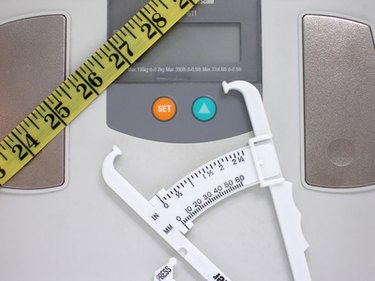
Strain gauge load cells are by far the most common type of load cell-based weighing system in 2010. Strain gauge load cell weighing systems convert weights into analog output signals that can be further conditioned to indicate weight in digital meters and control systems. They are used in every area of human endeavor, including commerce, transportation, science and technology, and industry to provide highly accurate real-time weight information. The conversion of load cell readings into useful total weight information requires several calculations based on the load cell's calibration specifications.
Pound-Unit Conversion
Video of the Day
Step 1
Obtain the individual load cell's characteristics. These will usually be shown as basic resistance in ohms, recommended excitation voltage, and sensitivity expressed as mv/V per unit weight in pounds, or millivolts-per-volt, and maximum weight capacity in pounds.
Video of the Day
Step 2
Multiply the load cell's reading in millivolts by the full scale weight of the load cell. If the load cell's reading is 27 millivolts, (0.027-volts) and the load cell's maximum sensing weight is 100 pounds, this multiplication will yield 2.7 volt-pounds.
Step 3
Divide the product from Step 2, 2.7 volt-pounds, by sensitivity in millivolts/volt times the excitation voltage. If the load cell's sensitivity is 3 mv/V and the excitation voltage provided by the converter is 10 volts, then the divider will be 30 millivolts or 0.03 volts. The division operation will be 2.7 volt-pounds divided by 0.03 volts, yielding a weight of 90 pounds on the scale using the load cell. A digital weigh-scale meter would perform this calculation automatically and read out 90.0 pounds on its indicator face.
Kilograms–Unit Conversion
Step 1
Obtain the individual load cell's characteristics. These will usually be shown as basic resistance in ohms, recommended excitation voltage and sensitivity expressed as mv/V excitation, per unit weight in kilograms, or millivolts-per-volt, and maximum weight capacity in kilograms.
Step 2
Multiply the load cell's reading in millivolts by the full scale weight of the load cell. If the load cell's reading is 14 millivolts, (0.014-volts) and the load cell's maximum sensing weight is 500 kilograms, this multiplication will yield 7 volt-kilograms.
Step 3
Divide the product from Step 2, 7 volt-kilograms, by sensitivity in millivolts/volt times the excitation voltage. If the load cell's sensitivity is 2 mv/V and the excitation voltage provided by the converter is 10 volts, then the divider will be 20 millivolts or 0.02 volts. The division operation will be 7 volt-kilograms divided by 0.02 volts, yielding a weight of 350 kilograms on the scale using the load cell. A digital weigh-scale meter would perform this calculation automatically and read out 350.0 kilograms on its indicator face.